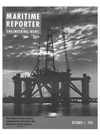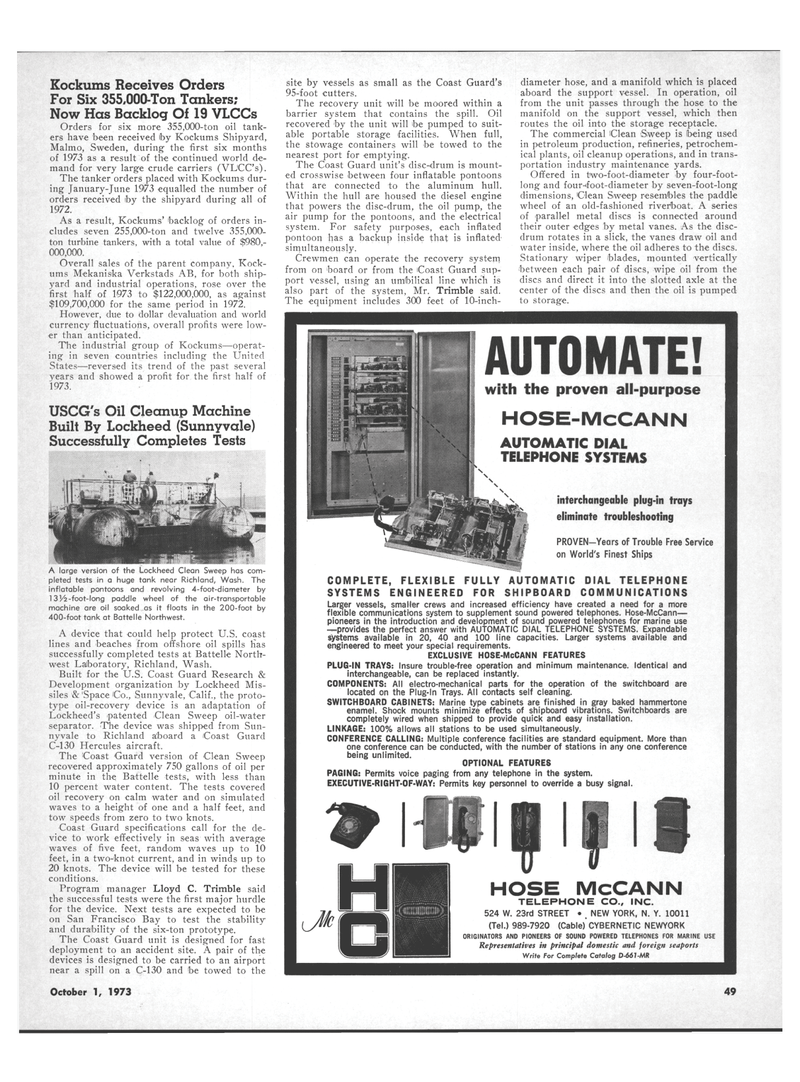
Page 47: of Maritime Reporter Magazine (October 1973)
Read this page in Pdf, Flash or Html5 edition of October 1973 Maritime Reporter Magazine
Kockums Receives Orders
For Six 355,000-Ton Tankers;
Now Has Backlog Of 19 VLCCs
Orders for six more 355,000-ton oil tank- ers have been received iby Kockums Shipyard,
Malmo, Sweden, during the first six months of 1973 as a result of the continued world de- mand for very large crude carriers (VL'CC's).
The tanker orders placed with Kockums dur- ing January-June 1973 equalled the number of orders received iby the shipyard during all of 1972.
As a result, Kockums' backlog of orders in- cludes seven 255,000-ton and twelve 355,000- ton turbine tankers, with a total value of $980,- 000,000.
Overall sales of the parent company, Kock- ums Mekaniska Verkstads AB, for both ship- yard and industrial operations, rose over the first half of 1973 to $122,000,000, as against $109,700,000 for the same period in 1972.
However, due to dollar devaluation and world currency fluctuations, overall profits were low- er than anticipated.
The industrial group of Kockums—operat- ing in seven countries including the United
States—reversed its trend of the past several years and showed a profit for the first half of 1973.
USCG's Oil Cleanup Machine
Built By Lockheed (Sunnyvale)
Successfully Completes Tests
A large version of the Lockheed Clean Sweep has com- pleted tests in a huge tank near Richland, Wash. The inflatable pontoons and revolving 4-foot-diameter by 13Vi-foot-long paddle wheel of the air-transportable machine are oil soaked as it floats in the 200-foot by 400-foot tank at Battelle Northwest.
A device that -could help protect U.S. coast lines and beaches from offshore oil spills has successfully completed tests at Battelle North- west Laboratory, Richland, Wash.
Built for the U.S. Coast Guard Research &
Development organization by Lockheed Mis- siles & 'Space Co., Sunnyvale, Calif., the proto- type oil-recovery device is an adaptation of
Lockheed's .patented Clean Sweep oil-water separator. The device was shipped from Sun- nyvale to Richland aboard a Coast Guard
C-130 Hercules aircraft.
The Coast Guard version of Clean Sweep recovered approximately 750 gallons of oil per minute in the Battelle tests, with less than 10 percent water content. The tests covered 011 recovery on calm water and on simulated waves to a height of one and a half feet, and tow speeds from zero to two knots.
Coast Guard specifications call for the de- vice to work effectively in seas with average waves of five feet, random waves up to 10 feet, in a two-knot current, and in winds up to 20 knots. The device will be tested for these conditions.
Program manager Lloyd C. Trimble said the successful tests were the first major hurdle for the device. Next tests are expected to be on San Francisco Bay to test the stability and durability of the six-ton prototype.
The Coast Guard unit is designed for fast deployment to an accident site. A pair of the devices is designed to be carried to an airport near a spill on a C-130 and be towed to the site by vessels as small as the Coast Guard's 95-foot cutters.
The recovery unit will be moored within a barrier system that contains the spill. Oil recovered by the unit will be pumped to suit- able portable storage facilities. When full, the stowage containers will be towed to the nearest port for emptying.
The Coast Guard unit's disc-drum is mount- ed crosswise between four inflatable pontoons that are connected to the aluminum hull.
Within the hull are housed the diesel engine that powers the disc-drum, the oil pump, the air pump for the pontoons, and the electrical system. For safety purposes, each inflated pontoon has a backup Inside that is inflated simultaneously.
Crewmen can operate the recovery system from on board or from the Coast Guard sup- port vessel, using an umbilical line which is also part of the system, Mr. Trimble said.
The equipment includes 300 feet of 10-inch- diameter hose, and a manifold which is placed aboard the support vessel. In operation, oil from the unit passes through the hose to the manifold on the support vessel, which then routes the oil into the storage receptacle.
The commercial Clean Sweep is being used in petroleum production, refineries, petrochem- ical plants, oil cleanup operations, and in trans- portation industry maintenance yards.
Offered in two-foot-diameter by four-foot- long and four-foot-diameter by seven-foot-long dimensions, Clean Sweep resembles the paddle wheel of an old-fashioned riverboat. A series of 'parallel metal discs is connected around their outer edges by metal vanes. As the disc- drum rotates in a slick, the vanes draw oil and water inside, where the oil adheres to the discs.
Stationary wiper blades, mounted vertically between each pair of discs, wipe oil from the discs and direct it into the slotted axle at the center of the discs and then the oil is pumped to storage. •J
P»*M
AUTOMATE! with the proven all-purpose
HOSE-McCANN
AUTOMATIC DIAL
TELEPHONE SYSTEMS
Lfr. X interchangeable plug-in trays eliminate troubleshooting
PROVEN—Years of Trouble Free Service on World's Finest Ships
COMPLETE, FLEXIBLE FULLY AUTOMATIC DIAL TELEPHONE
SYSTEMS ENGINEERED FOR SHIPBOARD COMMUNICATIONS
Larger vessels, smaller crews and increased efficiency have created a need for a more flexible communications system to supplement sound powered telephones. Hose-McCann— pioneers in the introduction and development of sound powered telephones for marine use —provides the perfect answer with AUTOMATIC DIAL TELEPHONE SYSTEMS. Expandable systems available in 20, 40 and 100 line capacities. Larger systems available and engineered to meet your special requirements.
EXCLUSIVE HOSE-McCANN FEATURES
PLUG-IN TRAYS: Insure trouble-free operation and minimum maintenance. Identical and interchangeable, can be replaced instantly.
COMPONENTS: All electro-mechanical parts for the operation of the switchboard are located on the Plug-In Trays. All contacts self cleaning.
SWITCHBOARD CABINETS: Marine type cabinets are finished in gray baked hammertone enamel. Shock mounts minimize effects of shipboard vibrations. Switchboards are completely wired when shipped to provide quick and easy installation.
LINKAGE: 100% allows all stations to be used simultaneously.
CONFERENCE CALLING: Multiple conference facilities are standard equipment. More than one conference can be conducted, with the number of stations in any one conference being unlimited.
OPTIONAL FEATURES
PAGING: Permits voice paging from any telephone in the system.
EXECUTIVE-RIGHT-OF-WAY: Permits key personnel to override a busy signal.
HOSE McCANN
TELEPHONE CO., INC. 524 W. 23rd STREET • _ NEW YORK, N. Y. 10011 (Tel.) 989-7920 (Cable) CYBERNETIC NEWYORK
ORIGINATORS AND PIONEERS OF SOUND POWERED TELEPHONES FOR MARINE USE
Representatives in principal domestic and foreign seaports
Write For Complete Catalog D-661-MR
October 1, 1973 49

 46
46

 48
48
